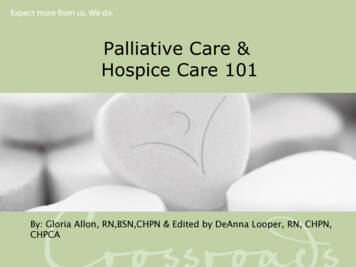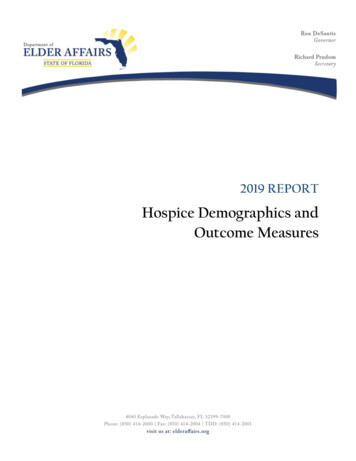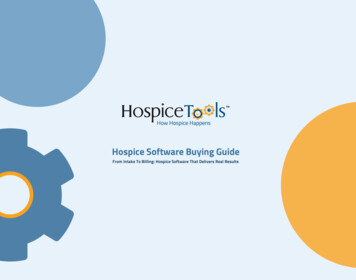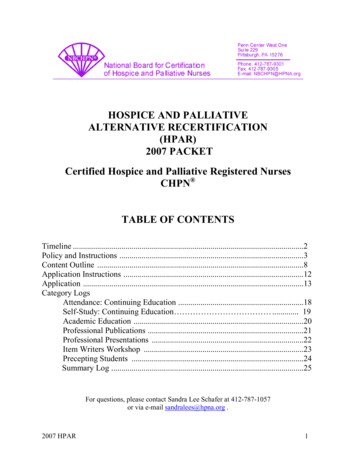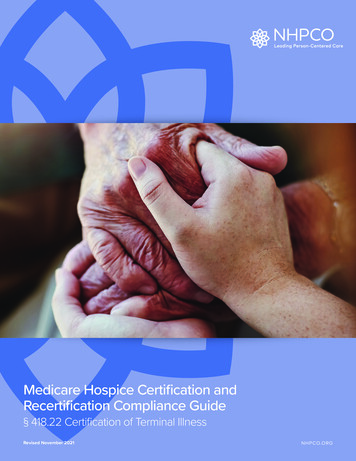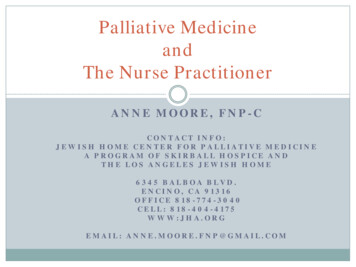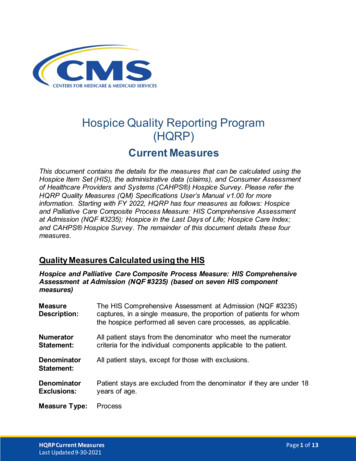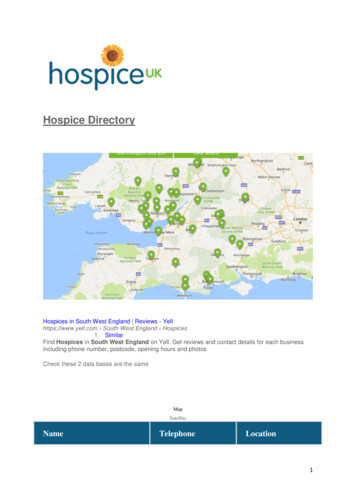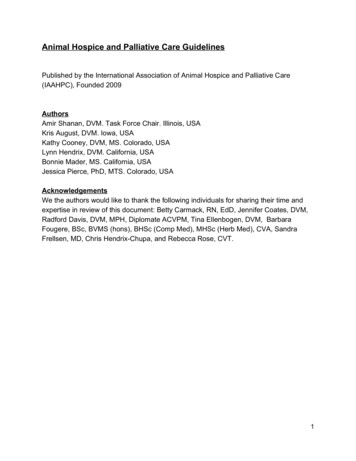
Transcription
Animal Hospice and Palliative Care GuidelinesPublished by the International Association of Animal Hospice and Palliative Care(IAAHPC), Founded 2009AuthorsAmir Shanan, DVM. Task Force Chair. Illinois, USAKris August, DVM. Iowa, USAKathy Cooney, DVM, MS. Colorado, USALynn Hendrix, DVM. California, USABonnie Mader, MS. California, USAJessica Pierce, PhD, MTS. Colorado, USAAcknowledgementsWe the authors would like to thank the following individuals for sharing their time andexpertise in review of this document: Betty Carmack, RN, EdD, Jennifer Coates, DVM,Radford Davis, DVM, MPH, Diplomate ACVPM, Tina Ellenbogen, DVM, BarbaraFougere, BSc, BVMS (hons), BHSc (Comp Med), MHSc (Herb Med), CVA, SandraFrellsen, MD, Chris Hendrix Chupa, and Rebecca Rose, CVT.1
Animal Hospice and Palliative Care GuidelinesTable of Contents:I. IntroductionII. Purpose and goals of the GuidelinesIII. Pain, suffering, well being, and quality of life in the animal hospice and palliativecare patient1. Physical and emotional suffering2. Animals’ individual preferences3. Quality of Life assessments4. Recognition of animal pain and pleasure5. Collaboration and consensusIV. Ethical and legal aspects of providing hospice and palliative care to animalsand their caregivers1. General considerations2. Euthanasia3. Pain and suffering4. Ethical business practices5. Legal aspectsV. Mental Health Considerations in Caring for Animal Hospice and PalliativeCaregivers1. The mental health aspect of caregiving2. Caregiving experience3. Experiencing grief4. Training in mental health and communication5. When to contact a mental health professional6. Grief and Bereavement Support for Caregivers7. Animal Hospice providers’ needs8. Compassion fatigueVI. Physical Considerations in Caring for Animal Hospice and Palliative Patients1. Primacy of physical pain management2. On going assessment3. On going communication2
4. Assessing the patient’s environment5. Continuity across settings6. Timeliness and efficacy7. Matching treatment to goals of care8. Triage and crisis preparednessVII. Care of the Patient at the End of Life1. Natural Death and Euthanasia2. Goals of caring for the patient at the end of life3. Advance preparation and education of team4. Prognostication5. Desirable environment of care6. Active Dying7. Euthanasia of animal hospice patientsVIII. Animal Hospice Nursing1. Caring for patients2. Supporting caregivers3. Role in the transdisciplinary teamIX. Integrative Veterinary Medicine in Animal Hospice and Palliative CareX. ConclusionXI. AppendixXII. References3
The International Association of Animal Hospice and Palliative Care’sAnimal Hospice and Palliative Care GuidelinesI. IntroductionThe knowledge base needed for relieving animals’ suffering and improving their quality oflife is growing rapidly. Our ability to recognize and to effectively manage pain in sick anddying animals is a remarkable example of the progress made in end of life and palliativecare. Recognition of the significant benefits of animal hospice and palliative care to humancaregivers is also growing. Animal hospice and palliative care help caregivers of ill ordying animals ease into an acceptance of death, provide time for them to adjustemotionally to the loss of their animal, and reduce the stresses arising from end of lifedecision making and care.Palliative care and hospice care are two separate concepts, though they are frequentlyconfused and are used interchangeably because of their significant overlap. Palliation isdefined as relieving or soothing the symptoms of a disease or disorder at any stage of anillness. Animal palliative care guides animals’ caregivers (their human family members orowners) in making plans for living well based on the animals’ needs and concerns and onthe caregivers’ goals for care. It also provides caregivers emotional and spiritual supportand guidance. Palliative care is of special significance in the context of terminal illness andend of life care. However, research has shown that palliative care expedites recovery fromillness, making it an important component of care during efforts to cure a patient’s illnessas well.Hospice care originates from concerns about the poor quality of care for terminally ill anddying patients by human healthcare systems during the mid to late twentieth century. It hasevolved over the past few decades to provide palliative care not only for the imminentlydying, but also for patients for whom a cure is no longer possible and whose condition hasbecome advanced, progressive, and incurable. Hospice care is about giving patients andcaregivers control, dignity, and comfort during the time they have remaining to live.Importantly, hospice care offers spiritual support to patients and accommodates theirbeliefs about death and about afterlife as much as possible. It also provides spiritual andgrief support for caregivers (Herbert 2007; Daaleman 2000).Animal hospice care has its origins in human hospice care philosophy, and though thereare many similarities and much to be learned from our human medical counterparts,significant differences can be appreciated. The human hospice movement frequently refersto the phrase “neither hasten nor postpone death” as a guiding principle. As the death of aperson becomes imminent, comfort care to relieve pain, anxiety, and other symptoms is4
provided, while life prolonging measures such as CPR or artificial respiration are avoidedwhen they no longer contribute to the patient’s quality of life. The same applies when thedeath of an animal becomes imminent. However, when caring for seriously ill animals,euthanasia is a legal and widely accepted option for relieving suffering.In order to acknowledge this distinction between human and animal end of life care, wehave chosen to use the term Animal Hospice to describe the continuum of palliative careprovided to companion animals nearing the end of life, including hospice supported naturaldeath as well as euthanasia. The term Veterinary Hospice has been used in the past bysome authors, but in our opinion it is more appropriate to place the emphasis on thepatients rather than on the providers in defining our field. In addition, the term AnimalHospice better reflects the importance of the transdisciplinary team required to fullyprovide hospice care for animals. We unanimously agree that such care cannot beprovided without the medical direction of a licensed veterinarian.The provision of care by a transdisciplinary team is a central tenet in palliative care andhospice philosophy and organization. Supervision by veterinarians with expertise inpalliative and end of life care is paramount to ensure that the most effective, humane, andethical medical treatments are provided to animals receiving hospice care. Goals of carecan then be defined by the animal’s caregivers in collaboration with the attendingveterinarian. Participation of expert non veterinary animal hospice team members is alsovital to adequately serve the complex needs of animal hospice patients and theircaregivers.Potential animal hospice team membersVeterinarians (core)PharmacistsVeterinary technicians (core)Pet sittersMental health professionals (core)Massage therapistsVeterinary assistantsAlternative therapy providersChaplainsCommunity volunteersPet crematory/cemetery staffBioethicistsAnimal hospice and palliative care are emerging fields. Veterinarians and otherprofessional animal care providers are seeking ways to provide end of life care in anethical and humane manner that serves the needs of animal patients as well as their humancaregivers. Applying insights and knowledge from bioethics will expedite the developmentof evidence based best practices in these emerging fields.These Guidelines are intended to be used by animal hospice and palliative care providers5
as they strive to provide optimal end of life care. The Guidelines assume that appropriatestandards of animal and veterinary care, and veterinary and animal welfare codes of ethics,will be upheld. Such standards include, but are not limited to, proper record keeping,professional education, ongoing professional collaboration, and continuing scientificresearch. The fields of animal hospice and palliative care are still in the early stages ofdevelopment and these Guidelines will require revision as evidence based knowledgeadvances. In addition to an on going revision of these Guidelines, the IAAHPC iscommitted to developing further educational resources, training, and certification in animalhospice and palliative care.II. Purpose and Goals of the Guidelines:The IAAHPC Guidelines Task Force, consisting of leaders from relevant disciplines andusing a consensus process, has endeavored to compile a document to be used as aresource by animal hospice and palliative care providers so they can providecomprehensive and optimal care to animals at the end of life and their human familymembers. The purpose of these Guidelines is to define terminology and describe the coreprecepts and structures for the provision of high quality hospice and palliative care foranimals.Our goals include:1.Plan of Care Establish that animal hospice and palliative care strive to createan individualized, comprehensive, and transdisciplinary plan of care for each animalpatient and care giving family. The plan of care is based on a clear understanding ofcaregiver expectations and goals for the animal’s care before, during, and after death.2.Hospice Team Approach Outline the transdisciplinary hospice team approachto providing hospice and palliative care for animals and the people who care for them,and clarify the responsibilities of individual team members.3.Needs of Animal Patients Ensure that the physical and emotional needs ofanimal patients are protected and nurtured, and that utmost attention is given tominimizing pain and suffering in ill and dying animals.4.Care of Animals at the End of Life Address specific considerations forproviding humane and ethical care for the imminently dying patient, including provisionfor euthanasia or hospice supported natural death.5.Mental Health of Caregivers Establish the ethical importance ofappropriately supporting the mental health needs of caregivers, including psychological,emotional, social, spiritual, religious, and cultural needs.6.Ethical and Legal Aspects of Care Consider and provide guidance on6
ethical and legal aspects of providing hospice and palliative care for animals.III. Pain, Suffering, Well Being, and Quality of Life in the AnimalHospice and Palliative Care Patient1. Physical and emotional suffering2. Animals’ individual preferences3. Quality of Life assessments4. Recognition of animal pain and pleasure5. Collaboration and consensus3.1 Physical and emotional suffering3 1.1 Objective of care. The objective of animal hospice and palliative care is to addressa broad range of physical and emotional suffering that may be experienced by animalsreceiving end of life care.3 1.2 Physical pain. The care of animal hospice and palliative care patients must makeidentifying and addressing physical pain a primary and ongoing concern. Because animalscannot express their experiences in the currency of human words, and because manyspecies of animal have evolved to hide signs of pain, it is important to be vigilant inobserving and identifying physiological and behavioral manifestations of pain. Injuries ordisease processes known to be painful in humans should be considered to be potentiallypainful in animals. It is essential that those providing animal hospice and palliative carehave advanced knowledge of assessing and treating pain, and caregivers are coached onhow to identify pain in their animals (AAHA/AAFP 2007).For additional discussion of physical pain management in animal hospice andpalliative care please refer to sections 6 1 and 7 5.3 of these Guidelines.3 1.3 Pain assessment strategies. The most effective approach to the assessment andmanagement of pain involves the use of several combined strategies: clinical evaluation,observation of behavioral changes, diagnosis, and response to therapy. The use of painscores or scales has been shown to increase caregivers and animal hospice providers’awareness to subtle changes in the animal patient’s pain level (Gaynor and Muir 2009).There is currently no “gold standard” for assessing animal pain, and considerable researchis still needed in this area. Because chronic pain can manifest differently than acute pain,7
development of unique scoring systems is an important goal of future research. Animalhospice and palliative care providers should know species specific signs of pain for therange of animals they treat.3 1.4 Chronic pain management. Chronic pain is of particular significance in the contextof animal hospice and palliative care, where the slow progression of illness or age cansubtly but insidiously undermine an animal’s well being. Chronic pain is differentphysiologically from acute pain and more difficult to measure and identify (Fox 2010).Because the behavioral signs of chronic pain in animals may be quite subtle, caregiversmay believe an animal is simply “tired,” “slowing down,” or “getting stiff.” Education ofcaregivers in identifying chronic pain is essential in the animal hospice setting. Chronicpain can also be more frustrating to treat; often a number of different pain treatments ormodalities must be tried, alone and in combination, to achieve the best response possible.3 1.5 Sources of suffering. In addition to physical pain, ill and dying animals can alsoexperience profound suffering due to respiratory distress, nausea, compromised mobility,confinement, social isolation, confusion, agitation, boredom, frustration, anxiety, fear,depression and other sensory or emotional experiences (Gregory 2004; McMillan 2005).Those caring for dying animals are strongly encouraged to identify all sources of sufferingand, wherever possible, provide relief.3 1.6 Emotional suffering. Although there is broad scientific consensus that all mammalsexperience a similar range of emotions, we know less about the emotional experiences ofanimals than about other aspects of cognition (Panksepp 1982 and 1998; Panksepp andBiven 2012; Bekoff 2005). Emotional suffering is intuitively assumed to be one of the mostimportant forms of suffering, yet it is one of the least studied consequences of animalillness (Gregory 2004). The evolving science of animal emotions is highly relevant to thedevelopment of compassionate care at the end of life and continued research into this areais of utmost importance to the developing field of animal hospice and palliative care.3 1.7 Human suffering as model. The human experience of suffering can serve as ageneral guide to understanding suffering in nonhuman animals. At the same time, usinghuman suffering as a model for animal suffering has limitations. It is well known thatdifferent species of animals vary in sensory, emotional, and cognitive capabilities, whichcan have implications for the specific conditions causing suffering. For example, noisesthat humans cannot hear might be very stressful for an animal with a broader or differentauditory range.3 1.8 Physical discomfort. Although physical discomfort is a frequent cause of suffering,8
caregivers, veterinarians, and other members of the animal hospice team, should bear inmind that physical discomfort may be experienced yet not cause substantial suffering,since different patients may have different thresholds and cope differently with similarsensory stimuli. Equally, the absence of physical discomfort does not ensure the absenceof suffering.3 2. Animals’ individual preferences3 2.1 Behavior and affect. The objective of animal hospice and palliative care treatmentdecisions is to optimize the patients’ quality of life. Therefore it is important to basedecisions about care on an understanding of the animal’s feelings, experiences, andpreferences. We can gather a great deal of information by carefully observing an animal’sbehavior, physiological state, and nonverbal communications (Wemelsfelder 2007).Knowledge of species specific behavior is extremely important, as is an attunement toindividual personality. It is also essential to keep in mind that animals often mask theirfeelings—and, in particular, they often mask their pain—so overt behaviors are not alwaysa reliable measure of an animal’s inner state. There are, however, many subtle behavioralsigns reflecting animals’ inner state, making astute and educated observation paramount.In particular, we should remain attuned to an animal’s “will to live,” which is of greatimportance in making end of life decisions but is difficult to define and measure.3 2.2 Ethology. Research in ethology is continuing to generate new knowledge of howanimal preferences are expressed in observable behaviors. Still, our understanding ofanimal preferences, and of the physiology and behaviors associated with animal suffering,is in a relatively early phase of discovery and development, and the field of animal hospiceand palliative care will need to stay current with new knowledge as it becomes available.3 3 Quality of Life assessments3 3.1 Quality of Life. Quality of life refers to the total well being of an individual animal,taking into account the physical, social, and emotional components of the animal’s life.Within hospice care, assessments of an animal’s quality of life typically reflect how ananimal’s total well being is affected by disease, disability, or changes related to advancedage. Assessing patients’ quality of life is one of the essential tasks of the animal hospiceteam. There are currently no broadly accepted or standard protocols for assessing animalquality of life, but a small and growing effort is underway to develop validated anduser friendly quality of life assessment protocols for use by caregivers of ill or dyinganimals (Hewson et al. 2007; Iliopoulou et al. 2013; Lavan 2013; Lynch et al. 2010; Noli etal. 2011; Wiseman Orr et al. 2004; Wojciechowska and Hewson 2005; Yazbek and9
Fantoni 2005; Yeates and Main 2009). Continued research in this area is vitally important.3 3.2 Available resources for assessment. Quality of life assessments are crucial to theprovision of good animal hospice care. They are also often the fulcrum for decision makingabout euthanasia, and thus need to be as thorough and precise as possible. It is the viewof the authors of these Guidelines that the science and art of assessing seriously illanimals’ quality of life is in its infancy. In the absence of direct knowledge and deeperunderstanding, we have to extrapolate from the available resources regarding humanquality of life, animal welfare, animal emotions and cognition, the physiology and behaviorsrelated to suffering, and broader ethical and philosophical foundations.3 3.3 Tracking. Quality of life assessments involve a collaborative effort amongveterinarians, other animal hospice team members, and caregivers, and rely on carefulobservation of an animal. They encourage us to ask “what is important to this animal in hisor her life?” and to remember that each individual animal has unique likes and dislikes. Forexample, loss of mobility might negatively impact a dog who loves to play ball and Frisbeemore significantly that it would a dog whose favorite activity is sleeping in a sunny spotunder a window. Individual animals also have unique capacities to adapt to change. Adisabled animal may continue to enjoy his or her favorite activities if creatively modified tofit the animal’s condition. A disabled animal may also develop “new” favorite activities.Quality of life assessments track important behaviors over time; and should provide awritten record that can guide discussions about care options and facilitate findingconsensus on end of life decisions.3 3.4 Monitoring. Quality of life assessments are ongoing, as caregivers and animalhospice team members monitor the well being of an animal. Caregivers, in particular,should assess quality of life daily and keep a written record. An attending veterinarian orqualified veterinary nurse should perform a medical assessment as often as needed but atleast weekly. An animal who is declining rapidly requires more frequent monitoring thanone who is relatively stable. Quality of life assessments depend on identifying and trackingtrends in the animal’s well being. Keeping a written record and making frequententries—even very brief ones—can be extremely valuable in this effort.3 3.5 Factors in assessment. Some of the factors that impact quality of life for animalsinclude physical pain, nausea, inappetence, respiratory distress, loss of mobility,incontinence, dehydration, boredom, anxiety, and the inability to engage in meaningful andenjoyable activities. Some popular quality of life assessment tools use a numerical scoringsystem (Villalobos 2004). While tools like this can be a good guide, it may be necessaryfor caregivers to weigh some factors like respiratory distress and severe pain more heavily10
than other factors like incontinence or the inability to play catch.3 3.6 Context of assessment. Quality of life assessments for the imminently dying patientare unique because some supposed indicators of poor quality of life—for exampleinappetence and loss of mental acuity—are a natural part of the dying process.Assessments of quality of life must take into account the broader context within which suchassessments are being made.3 3.7 Distinctions in assessment. Quality of life assessments need to reflect what isimportant for the animal, not the caregiver or animal hospice providers. The needs,limitations and interests of human caregivers and providers certainly influence decisionsabout care, but these are distinct from our assessments of an animal’s quality of life.3 4 Emotional well beingCaring for animals’ emotional well being is as essential as caring for their physicalsymptoms. Giving attention to animals’ emotional well being involves doing whateverpossible to both prevent or alleviate negative emotional states (through managing pain,reducing sources of anxiety, minimizing boredom and isolation, etc.) and maximizehappiness (through attention to the need for mental stimulation, social interactions andaffection, good foods, comfortable environment, opportunities for play, and so forth). Whatexactly provides pleasure will be unique to each individual; thus, careful attention might beplaced on the unique life experience, personality, and preferences of the animal patient.Because emotional states are temporal and shifting, quality of life assessments shouldfollow a trajectory over time and seek to understand and value past, present and futureexperiences. Scientific research into “purpose and/or meaning in life” for animals at thistime is very limited, but it is likely that animals do experience overall feelings of happinessor well being, and not just momentary and shifting mood states. Continued research intoanimal mental states will undoubtedly shed new light on these questions (Mendl et al. 2010;McMillan 2005, Panksepp 2004).3 5. Collaboration and consensus3 5.1 Resolution of caregiving disagreements. There will be times when caregiversand animal hospice team members disagree about how well or poorly an animal is doing. Itis important to attend to conflicts effectively as they emerge, to prevent them fromundermining proper, timely medical care of the animal patient. Utilizing the expertise of alicensed mental health professional to resolve conflicts involving animal hospice caregiversand/or providers is encouraged and in some cases warranted. Knowledge gained from11
research in bioethics and the experience of human hospice ethics committees can also behelpful in resolving such conflicts. Efforts should be made to get as close as possible,through collaboration and communication, to a consensus quality of life assessment bycaregivers and providers involved in making decisions about the animal’s care at the endof life. Collaboration and communication offer the best approach to minimizing the risk oferrors when making end of life decisions for animals. If conflicts cannot be adequatelyresolved, consultation with a licensed mental health professional can be helpful (O’Gradyand Jadad 2010).3 5.2 Attitudes and assumptions of caregivers. All human caregivers and providersare influenced by their own conscious or subconscious attitudes toward pain and sufferingand will likely bring various assumptions and past experiences to the table when makingquality of life assessments.IV. Ethical and legal aspects of Providing Hospice and PalliativeCare to Animals and Their Caregivers1. General considerations2. Euthanasia3. Pain and suffering4. Ethical business practices5. Legal aspects of animal hospice4 1 General considerations4 1.1 Needs and well being. The needs and well being of the animal patient form thebackbone of any end of life care plan.4 1.2 Expressive behavior in animals. Animal hospice works from the premise thatanimals are cognitively and emotionally complex and are capable of experiencing a broadrange of physical and emotional suffering, as well as positive emotional states such aspleasure and happiness. Although non human animals experience much the same kind ofphysical and emotional suffering as humans, the way suffering becomes manifest, bothphysiologically and behaviorally, varies widely from species to species and betweenindividuals. Animal hospice professionals need to have an excellent working knowledge ofnormal species specific behaviors, as well as behaviors related to the expression of12
various kinds of pain, distress, and suffering.4 1.3 Preferences in animals. Animals form preferences, have unique likes and dislikes,and could be said to have some measure of autonomy. Although they cannot express theirfeelings and thoughts verbally, they can and do communicate their preferences in variousways. The animal hospice team are encouraged to elicit the preferences of the animalpatient, if possible, through observation and through dialogue with human caregivers.4 1.4 Communication on going, open, effective. Animal hospice professionals andcaregivers have different and complementary understandings of an animal’s behavior, andshould maintain open, effective, and on going communication about an animal patient’sdiagnosis, treatment, and quality of life.4 1.5 Educating caregivers. Animal hospice professionals can use their knowledge ofanimal behavior to help caregivers learn how to attend to the specific needs andpreferences of their animal. The team can share its knowledge about animals’ wide rangeof suffering and pleasurable experiences with the caregivers, and coach them creatively tokeep their animals happy and comfortable.4 1.6 Identifying caregiver decision makers. The animal hospice team will need toidentify the decision makers among an animal’s caregivers, and elicit their goals, beliefs,values, and potential conflicts with others in the family over the goals of care.4 1.7 Conflicts within the therapeutic triad. The “therapeutic triad” ofanimal caregiver hospice provider is complex and conflicts of interest and values arebound to arise. The animal hospice team is encouraged to proactively seek out values orgoals that may conflict with the welfare of the animal, recognize areas of conflict (orpotential conflict) between client and animal hospice care team, and seek to keep lines ofcommunication open. Timely referrals to mental health professionals may be appropriateas soon as impassable conflicts appear.4 1.8 Compassion fatigue. Compassion fatigue can affect animal hospice teammembers who provide end of life care and euthanasia. Emotional support services byqualified professionals for animal hospice providers are essential and should be madeavailable to all members of the team if the need arises.For additional discussion of compassion fatigue in animal hospice and palliativecare please refer to section 5 7 of these Guidelines.13
4 1.9 Responses to inadequate care. The issue of inadequate care is of particularconcern with ill or dying animals. Animal hospice providers will encounter situations inwhich human caregivers fail to provide adequate care for an animal. Animal hospice teammembers should continue to educate clients in identifying pain and suffering in their animaland in proper treatment. The timely involvement of a mental health professional may beneeded to ensure caregivers have the support they need to cope with the demands ofproperly caring for their animal. A judgmental and/or adversarial approach to caregivers inthese situations is counter productive and may lead to decreasing quality of care for theanimal if caregivers no longer seek veterinary advice.4 1.10 Advising caregivers. Caregivers should be advised openly and upfront about thefinancial, practical, and physical demands of appropriate animal hospice and palliativecare.4 1.11 Advance planning. Advance planning for end of life care and aftercare should beencouraged.4 1.12 Principles of Veterinary Ethics. Basic professional obligations as outlined in theAVMA’s Principles of Veterinary Ethics are applicable to all veterinarians who provideanimal hospice and palliative care services (AVMA 2013).4 2 Animal Pain and suffering4 2.1 Attention to pain and distress. Inadequate attention to pain and distress is aserious ethical and practical concern within veterinary medicine, and is of particularimportance in the realm of end of life care. Veterinarians who specialize in animal hospicecare should be knowledgeable in pain management and palliative care, and in thephysiology and behavior of animal suffering.4 2.2 Acute pain. Veterinarians must attend to acute pain in a timely manner. If 24 hourservices are not available, clients with animals who may experience a medical crisisshould be provided with emergency pain medications and clear information explainingwhat to do
VIII. Animal Hospice Nursing 1. Caring for patients 2. Supporting caregivers 3. Role in the transdisciplinary team IX. Integrative Veterinary Medicine in Animal Hospice and Palliative Care X. Conclusion XI. Appendix XII. References 3
